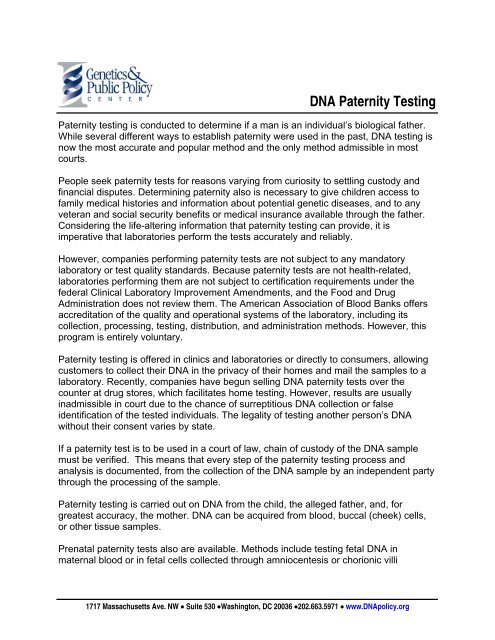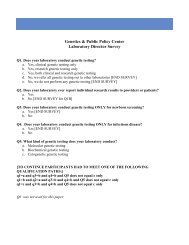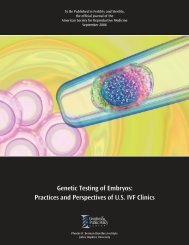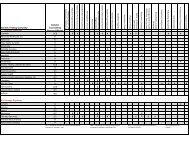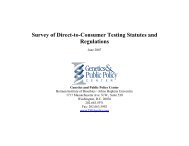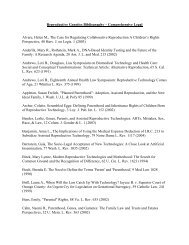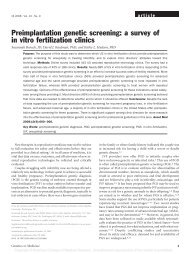DNA Paternity Testing
DNA Paternity Testing
DNA Paternity Testing
You also want an ePaper? Increase the reach of your titles
YUMPU automatically turns print PDFs into web optimized ePapers that Google loves.
<strong>DNA</strong> <strong>Paternity</strong> <strong>Testing</strong><br />
<strong>Paternity</strong> testing is conducted to determine if a man is an individual’s biological father.<br />
While several different ways to establish paternity were used in the past, <strong>DNA</strong> testing is<br />
now the most accurate and popular method and the only method admissible in most<br />
courts.<br />
People seek paternity tests for reasons varying from curiosity to settling custody and<br />
financial disputes. Determining paternity also is necessary to give children access to<br />
family medical histories and information about potential genetic diseases, and to any<br />
veteran and social security benefits or medical insurance available through the father.<br />
Considering the life-altering information that paternity testing can provide, it is<br />
imperative that laboratories perform the tests accurately and reliably.<br />
However, companies performing paternity tests are not subject to any mandatory<br />
laboratory or test quality standards. Because paternity tests are not health-related,<br />
laboratories performing them are not subject to certification requirements under the<br />
federal Clinical Laboratory Improvement Amendments, and the Food and Drug<br />
Administration does not review them. The American Association of Blood Banks offers<br />
accreditation of the quality and operational systems of the laboratory, including its<br />
collection, processing, testing, distribution, and administration methods. However, this<br />
program is entirely voluntary.<br />
<strong>Paternity</strong> testing is offered in clinics and laboratories or directly to consumers, allowing<br />
customers to collect their <strong>DNA</strong> in the privacy of their homes and mail the samples to a<br />
laboratory. Recently, companies have begun selling <strong>DNA</strong> paternity tests over the<br />
counter at drug stores, which facilitates home testing. However, results are usually<br />
inadmissible in court due to the chance of surreptitious <strong>DNA</strong> collection or false<br />
identification of the tested individuals. The legality of testing another person’s <strong>DNA</strong><br />
without their consent varies by state.<br />
If a paternity test is to be used in a court of law, chain of custody of the <strong>DNA</strong> sample<br />
must be verified. This means that every step of the paternity testing process and<br />
analysis is documented, from the collection of the <strong>DNA</strong> sample by an independent party<br />
through the processing of the sample.<br />
<strong>Paternity</strong> testing is carried out on <strong>DNA</strong> from the child, the alleged father, and, for<br />
greatest accuracy, the mother. <strong>DNA</strong> can be acquired from blood, buccal (cheek) cells,<br />
or other tissue samples.<br />
Prenatal paternity tests also are available. Methods include testing fetal <strong>DNA</strong> in<br />
maternal blood or in fetal cells collected through amniocentesis or chorionic villi<br />
1717 Massachusetts Ave. NW • Suite 530 •Washington, DC 20036 •202.663.5971 • www.<strong>DNA</strong>policy.org
sampling. Because a slightly increased risk of miscarriage accompanies these two<br />
methods, they are not routinely recommended solely for paternity determination.<br />
After <strong>DNA</strong> is collected, certain regions of the child’s <strong>DNA</strong> are compared with those of<br />
the mother and the alleged father. In general, the sequences that do not match the<br />
mother are presumed to come from the biological father. <strong>Paternity</strong> even can be<br />
determined if the alleged father is deceased or unavailable for testing: Using genetic<br />
tests from other members of his family, the alleged father’s genotype can be inferred<br />
and compared to the child’s.<br />
Many companies claim to offer paternity testing that is more than 99 percent accurate.<br />
Test quality depends on the skill of the laboratory personnel performing the test, how<br />
closely they follow proper procedures, the accuracy of the methodology, and how the<br />
results are interpreted. Since test quality can vary among laboratories and there are no<br />
mandatory standards, consumers should verify a company’s policies and accreditations<br />
before purchasing a test.<br />
Compiled by Katherine Groff<br />
1717 Massachusetts Ave. NW • Suite 530 •Washington, DC 20036 •202.663.5971 • www.<strong>DNA</strong>policy.org


